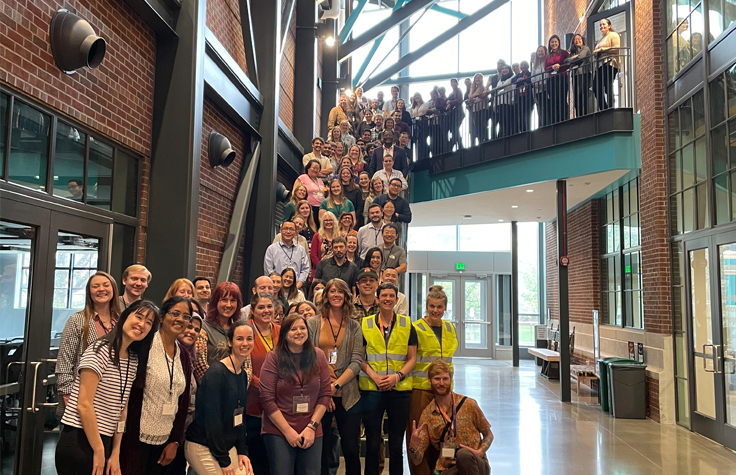Public health laboratories don’t just keep an eye on human disease. Pathogens in wild, domestic, and agricultural animals can significantly affect society, too. The most notable example now is avian influenza, or bird flu: This year alone, over 30 million egg-laying chickens in the US died or were euthanized to prevent the spread of the virus—which significantly contributed to a record-high spike in egg prices. Bird flu has already made the jump to humans in isolated cases, and although no human-to-human transmission has yet occurred, the Centers for Disease Control and Prevention report that a mutation enabling this could create another pandemic.
Considering the threat that diseases like bird flu pose, a strong and consistent nationwide surveillance program is crucial. To meet the challenge, 64 veterinary diagnostic laboratories across the country have joined the National Animal Health Laboratory Network (NAHLN), part of the U.S. Department of Agriculture.
These labs currently rely mainly on PCR-based tests, which detect specific genomic targets. Often, more than one PCR test is required to identify relevant genomic targets to make a diagnosis. But the best way to look for suspected, unknown, and novel disease is to sequence the animal’s entire genome. To that end, many NAHLN laboratories have implemented Illumina DNA library preparation for whole-genome sequencing.
However, many diagnosticians are new to the technique. To ensure that every lab can consistently produce reliable, high-quality data, NAHLN organized two Next-Generation Sequencing Symposia in collaboration with representatives from Illumina’s Sales team and Service and Support team. These symposia were supported through American Rescue Plan Act funding provided to NAHLN and managed by the Colorado State University NAHLN laboratory.
Unpacking the Workshop in a Box
Over three days this May, 88 scientists from 49 laboratories across 39 states gathered at Michigan State University’s STEM Teaching and Learning Facility for the first symposium, to learn library prep the Illumina way. It was the largest “Workshop in a Box” educational program Illumina has ever organized.
MSU’s own veterinary diagnostic laboratory participated; their microbiologist and bioinformatician Kayla Conner-Halim, PhD, served on the symposium’s coordinating committee. Testing and regulatory work for agricultural animals—including whole-genome investigations into known and suspected disease—are a major part of her lab’s operations.
The symposium had two tracks: Those with little to no library prep experience joined the beginner track, attending seminars and hands-on training with Illumina DNA library preparation and the company’s NextSeq 1000 and NextSeq 2000 Systems. “We had 61 folks in that group who all prepared their own libraries,” Conner-Halim remembers. And though they were in a new lab, with new equipment and unfamiliar people, with the guidance and expertise of Illumina’s field application scientists, 55 of them successfully produced high-quality libraries. “That is a wonderful success in my book, especially considering that a lot of them had never done it before. People were really excited to come together and actually do the work, rather than just watch a video or read about it.”
Those who joined the advanced topics track explored deeper sequencing workflows and data analysis options, with focused discussions on targeted library prep methods such as Illumina Microbial Amplicon Prep (IMAP). The advanced track also featured an overview of Illumina’s newest and most powerful line of benchtop sequencers, the MiSeq i100 Series.
Conner-Halim says the event was a great opportunity for far-flung colleagues to finally meet in person, in the lovely Michigan springtime weather. In particular, she notes that the attendees were mostly technician-level, rather than laboratory managers—who seldom have the chance to travel for work. “They got to take this trip and really invest in their training, and I think a lot of people left feeling really valued.”
The second symposium, hosted at Colorado State University this month, focused on bioinformatics training—data pipeline development, quality control, and troubleshooting, all of which are extremely important in regulatory work. Conner-Halim estimates that 75% of the participants attended both events, and those who did analyzed the same data they produced in the first.
Sequencing all creatures great and small
Avian influenza is the use case that both symposia focused on. The training expanded the number of labs that can monitor the virus and advise on biosecurity measures or policy changes for farms, but the expertise the participants gain will readily translate to other cases, including any future disease outbreaks.
The more widespread and standardized these procedures become, the better public health agencies will be able to face the next pandemic—or, hopefully, prevent it before it spreads. “In 2020, a lot of public health labs were in the process of developing their sequencing capabilities—and then COVID hit,” Conner-Halim says. “They were building the plane while it was flying…and on fire. I don’t want to see the veterinary world in that situation, so it’s important that we prepare now.”
This event was the first of its kind, both for Illumina and NAHLN, and Conner-Halim stresses its value for strengthening the laboratory network as a whole: “In a world right now where science funding is very up-in-the-air and unsure, funding these sorts of experiences for scientists who are working for the greater good is so important.” ◆
